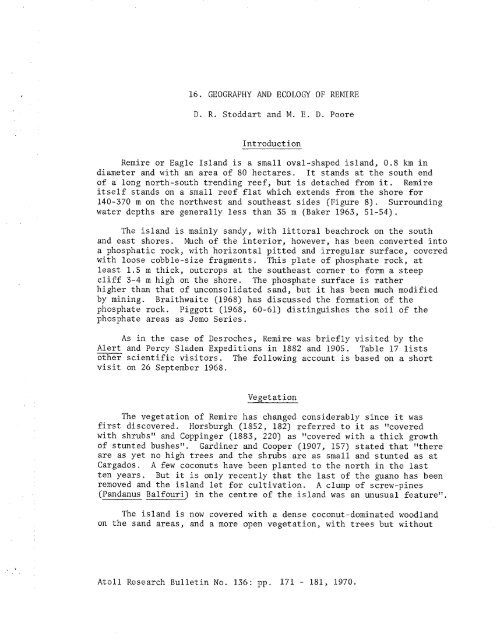ATOLL RESEARCH BULLETIN - Smithsonian Institution
ATOLL RESEARCH BULLETIN - Smithsonian Institution
ATOLL RESEARCH BULLETIN - Smithsonian Institution
You also want an ePaper? Increase the reach of your titles
YUMPU automatically turns print PDFs into web optimized ePapers that Google loves.
16. GEOGRAPHY AND ECOLOGY OF REMIRE<br />
D. R. Stoddart and M. E. D. Poore<br />
Introduction<br />
Remire or Eagle Island is a small oval-shaped island, 0.8 km in<br />
diameter and with an area of 80 hectares. It stands at the south end<br />
of a long north-south trending reef, but is detached from it. Remire<br />
itself stands on a small reef flat which extends from the shore for<br />
140-370 m on the northwest and southeast sides (Figure 8). Surrounding<br />
water depths are generally less than 35 m (Baker 1963, 51-54).<br />
The island is mainly sandy, with littoral beachrock on the south<br />
and east shores. Much of the interior, however, has been converted into<br />
a phosphatic rock, with horizontal pitted and irregular surface, covered<br />
with loose cobble-size fragments. This plate of phosphate rock, at<br />
least 1.5 m thick, outcrops at the southeast corner to form a steep<br />
cliff 3-4 m high on the shore. The phosphate surface is rather<br />
higher than that of unconsolidated sand, but it has been much modified<br />
by mining. Braithwaite (1968) has discussed the formation of the<br />
phosphate rock. Piggott (1968, 60-61) distinguishes the soil of the<br />
phosphate areas as Jemo Series.<br />
As in the case of Desroches, Remire was briefly visited by the<br />
- Alert and Percy Sladen Expeditions in 1882 and 1905. Table 17 lists<br />
other scientific visitors. The following account is based on a short<br />
visit on 26 September 1968.<br />
Vegetation<br />
The vegetation of Remire has changed considerably since it was<br />
first discovered. Horsburgh (1852, 182) referred to it as "covered<br />
with shrubs" and Coppinger (1883, 220) as "covered with a thick growth<br />
of stunted bushes". Gardiner and Cooper (1907, 157) stated that "there<br />
are as yet no high trees and the shrubs are as small and stunted as at<br />
Cargados. A few coconuts have been planted to the north in the last<br />
ten years. But it is only recently that the last of the guano has been<br />
removed and the island let for cultivation. A clump of screw-pines<br />
(Pandanus Balfouri) in the centre of the island was an unusual feature".<br />
The island is now covered with a dense coconut-dominated woodland<br />
on the sand areas, and a more open vegetation, with trees but without<br />
Atoll Research Bulletin No. 136: pp. 171 - 181, 1970.

















